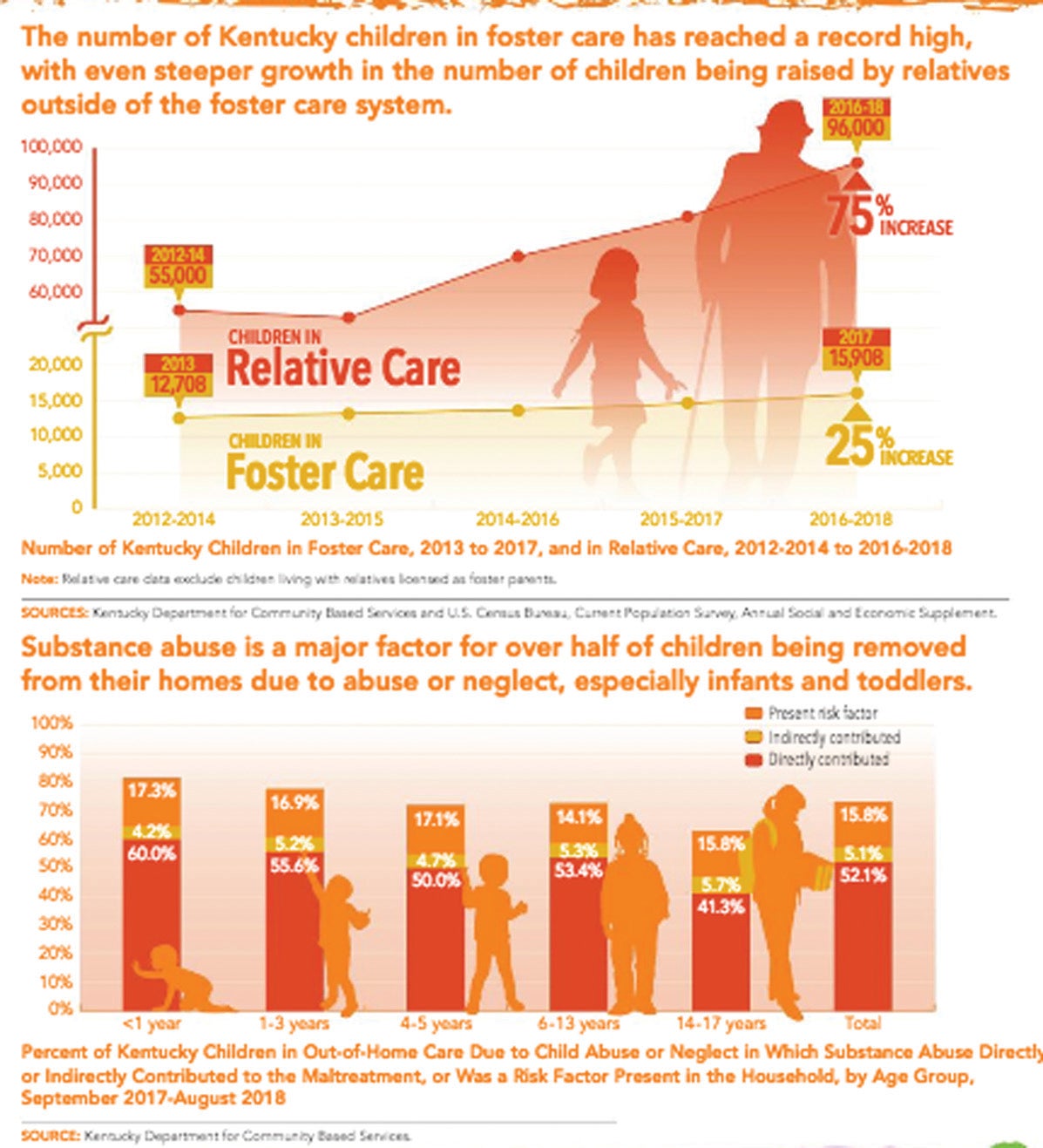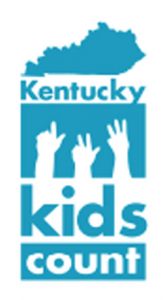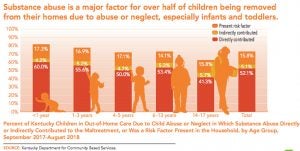More Boyle kids in out-of-home care
Published 6:49 am Friday, November 23, 2018

- Graphic contributed
Life for Boyle County kids has improved in almost all areas in recent years, except one: children in out-of-home care. That’s according to the 2018 Kentucky Kids Count County Data Book, released earlier this month.
For 2011-2013, 53.9 out of every 1,000 Boyle County kids were being cared for by foster parents or in an emergency placement; that jumped to 67.2 kids out of every 1,000 in 2015-2017. Boyle’s rate is more than 50 percent higher than the state average; the county is ranked 97th out of 119 counties reporting.
Boyle’s child population in 2017 was 6,012 for ages 0-17 and 1,592 for ages 0-4.

Graphic contributed
“The increase here is significant; very difficult for those children,” said Brent Blevins, director of the Boyle County Health Department. Statewide, the numbers also jumped — from 35.3 to 43.7 kids out of every 1,000.
The Kids Count book offers the latest data on 17 measures of child well-being and compares outcomes across the commonwealth — whether the stats have improved, worsened or stayed the same over a five-year period.
“I feel that our increase in those numbers can be looked at in a two-fold manner,” said Laura Guerrant, executive director for CASA of the Bluegrass. CASA trains volunteers to become court-appointed special advocates for kids who have entered the family court system due to neglect or dependency.
“I feel that there is a steady increase in issues that create out-of-home care situations — drug abuse, neglect, abuse,” Guerrant said. In October, Guerrant told the Boyle County Fiscal Court with a little over two months left to go in the year, CASA already has been assigned to the cases of 180 children. By comparison, that number for the entire year of 2017 was 125.
However, Guerrant also sees another side to these numbers.
“I also feel that our community’s staff of law enforcement, social service workers and family court personnel are committed to ensuring the safety of every child in danger.”
During the October fiscal court meeting, she told the court it will most definitely be one of CASA’s busiest years it’s ever had. One root cause of that is the drug epidemic in the community, she said. “The population of child victims in our community is growing because they are the collateral victims of a systemic problem that’s going on right now.”
The data is collected by Kentucky Youth Advocates, a non-profit children’s interest organization that seeks to improve the lives of Kentucky’s children and families. It considers itself an independent voice for the state’s children that works to ensure policymakers create investments and policies that are good for children.
The 2018 County Data Book allows users to investigate areas in which Kentucky and its counties are making progress and where focused attention is needed for improvement. It highlights data in four domains of child well-being: economic security, education, health and family and community.
In all other categories, Boyle’s numbers improved over the years.
Boyle saw a large decline in children living in food-insecure households — from 23.7 percent (2011) to 17.2 percent (2016).
“Considering that since Grace Café opened in July of 2015, and has served more than 59,000 meals on a pay-what-you-can basis, and is open everyday, I am quite sure our mission has contributed to decline of food insecurity (or increase in food security) in Boyle County,” said Rochelle Bayless, founder and executive director of Grace Café. Bayless said it’s all about access.
“And yes, I do think folks are more aware of the problem of hunger and food insecurity,” she said, and that organizations like Grace Café, Feeding America KY, the Kentucky Association of Food Banks, the State Hunger Initiative, among others, have all contributed to raising awareness throughout the state.
“The drop in teen births is a significant decrease,” Blevins said. For the years 2014-2016, teen births (ages 15-19) dropped to 30.1 out of 1,000 kids; it had been 34.1 in 2009-2011. Kentucky improved overall, with teen births decreasing 45.9 to 31.7 kids out of every 1,000.
Also dropping in Boyle is the number of pregnant mothers who smoke — 23.1 percent, down from 23.7 previously.
“I do like that the smoking during pregnancy dropped,” Blevins said. “With the opioid issues, it is sometimes easy to forget that tobacco use is still an issue in Kentucky.” Statewide, smoking during pregnancy dropped from 21.3 to 18.1 percent.
Births to mothers without a high-school degree in Boyle went from 16 out of every 1,000 females aged 15-19 in 2009-2011 to 14.1 in 2014-2016. A significant drop was seen in youth incarcerated in the juvenile justice system — from 44.8 out of 1,000 (2010-2012) to 13.2 (2015-2017). Statewide, the juvenile incarceration rate was 25.6 out of 1,000.
The percentage of children living in high-poverty areas also improved, from 46 percent in 2007-2011 to 23 percent in 2012-2016. Boyle was above the state average in this category, ranking 34th out of all counties. In Kentucky, the high-poverty statistic got worse, rising from 38 percent to 40 percent.
“As Kentucky gears up for the 2019 gubernatorial race, we know the toxic political climate will not magically cool down,” said Dr. Terry Brooks, executive director of Kentucky Youth Advocates. “It’s easy to talk about Frankfort in a cynical tone. But I would suggest that if there is one thing we can all agree on, regardless of political party or persuasion, it’s that we want the best for kids in Kentucky. There is no better common ground, common sense, and common good agenda than working to improve the lives of Kentucky kids.”

Graphic contributed
Education
Educationally, students in the Boyle County and Danville school districts improved in every area, with the exception of a drop in the percentage of kindergarteners who were ready to learn in the Danville Independent School District, from 33.1 percent in 2013-2014 to 32 percent in 2017-2018. Kindergartners in the Boyle County School District improved in this metric from 57.4 percent to 64 percent.
Elementary school students proficient in reading improved in Boyle schools from 63.7 percent in 2012-2013 to 78.7 percent in 2017-2018; and in Danville schools from 46.1 percent in 48.6 percent.
Middle school students proficient in math in Boyle went from 52.9 percent to 70.7 percent; Danville students went from 34.3 percent to 44.2 percent.
High school students graduating on time improved from 82.7 percent in 2012-2013 in Danville to 96 percent in 2017-2018. In Boyle, it went from 95.4 percent to 98.7 percent. Statewide, there were improvements seen across the board.
Other Boyle data highlights include:
• An increase in the percentage of people under the age of 19 with health insurance — from 93.9 percent (2011) to 97 percent (2016). Numbers improved statewide as well, from 93.5 to 96.7 percent.
• The rate of low birthweight babies stayed the same, at 7.7 percent, ranking Boyle 28th in Kentucky. Statewide, the rate improved from 9 percent in 2009-2011 to 8.8 percent in 2014-2016.
• Children in deep poverty (below 50 percent of the federal poverty level) fell from 10 percent in 2007-2011 to 6 percent in 2012-2016. The data stayed the same statewide at 12 percent.
• Children in poverty (below 100 percent of the federal poverty level) decreased from 24.8 percent in 2011 to 23.2 percent in 2016. A larger drop was seen statewide, going from 27.2 to 24.4 percent.
• The percentage of children in low-income families (below 200 percent of the federal poverty level) also improved, falling from 53 percent in 2007-2011 to 45 percent in 2012-2016. The number stayed the same statewide at 48 percent.
Statewide
• Kentucky has made progress in the percentage of children living in poverty, with improved rates in 93 out of 120 counties. But nearly one in four Kentucky kids still live in poverty.
• A high school diploma is essential to achieve economic self-sufficiency, and in 119 of 167 school districts, the rate of high-school students graduating on time has increased. Progress is still needed to improve graduation rates in the 46 school districts that worsened.
• After decades of progress, Kentucky’s rate of insured children has reached an all-time high at 96.7 percent. All 120 counties have improved rates in children having health coverage.
• Kentucky has improved overall in the percentage of low-birthweight babies, with 73 out of 120 counties seeing improvements, but 45 counties are going in wrong direction.
• The rate of children in out-of-home care continues to rise in 92 counties, fueled by parents struggling with addiction. The number of Kentucky children being raised by relatives outside of the foster care system also continues to rise, with a 75 percent increase between 2012-2014 and 2016-2018.
• More children in approximately half of Kentucky’s counties are living in high poverty areas (where at least 20 percent of residents are poor), which are much more likely to have high rates of crime, violence and unemployment; and lack of access to high-performing schools, quality health care and safe outdoor spaces.






